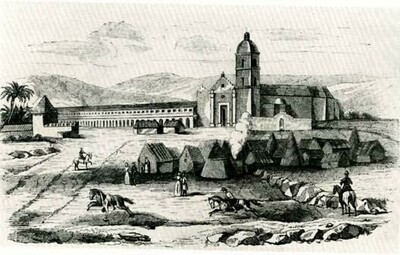History
Welcome to Mission San Luis Rey de Francia, King of the Missions.
Founded in 1798, by Padre Fermín Francisco de Lasuén, successor to Padre Junipero Serra, Mission San Luis Rey was named after St. Louis IX, King of France, who lived during the 13th century. The history of the San Luis Rey area reflects five periods of occupation: Luiseño Indian, Spanish Mission, Mexican Secularization, American Military, and Twentieth Century Restoration.
Luiseño Indians
Prior to Spanish occupation, the Luiseño people inhabited this area for hundreds of years. Their villages were located in valleys, along streams, by the coast, and near the mountains.
Luiseño homes (Kiichas) were dome-shaped and constructed of tulles over a branch frame. It was the chief and shaman who saw to it that laws were obeyed in the village. The women gathered most of the plants and food, while the men usually hunted for animals and fish. The Luiseños made tools, such as pestles for grinding and pounding, out of stone. They created baskets from grasses and natural fibers and used them for gathering and preparing food.
Spanish Missions
The establishment of the mission system in Alta California was not authorized until the threat of Russian encroachment into the area. In its long history of colonization, Spain had learned that land could be claimed inexpensively by establishing a mission and sending dedicated padres, a handful of soldiers, and a few supplies.
With a shortage of Spaniards in the New World, Spain decided to colonize with the indigenous people. The Franciscans were chosen not only to preach to the Indians but to teach them new skills so they could become productive citizens of Spain. Father Antonio Peyri was put in charge of Mission San Luis Rey, from the day of its founding on June 13, 1798, until his departure in January 1832. Between these years the Mission became home to approximately 3,000 Indians. In their name and as a result of their labor, the Mission cared for over 50,000 head of livestock. Large sections of the Mission’s lands were brought under cultivation. Grapes, oranges, olives, wheat, and corn were some of the crops produced. Fields were irrigated by water channeled from the river just north of the Mission. The Mission was self-sustaining; its buildings were constructed of local materials, such as adobe, fired clay bricks, and wooden timbers. By 1830, the Mission was the largest building in California.
Mexican Secularization
After Mexico won its independence from Spain in 1821, the law of secularization was passed. The idea behind the law was a simple one; each mission was given a ten-year period to fulfill their function of instructing the Indians.
After this time the missions were to be replaced by another colonial institution, the pueblo. This last step was long overdue in Alta California. The law came to the Mission in 1833. The law stated that the land was to be handed over to the Indians. However, Mission San Luis Rey came under the control of various secular administrators, several of whom managed to gain title to large portions of former mission land and thousands of cattle and sheep, leaving nothing to the Luiseños.
American Military
From 1847-1857 the Mission was used as an operational base by U.S. soldiers. Notable figures who served at the Mission include General Stephen W. Kearny, Kit Carson, and the Battalion of Mormon Volunteers, who served at the Mission for a period of six weeks.
Some of the troops stationed at the Mission were ordered to take charge and prevent any depredations upon it. Other troops assisted local ranchers in dismantling rooms and provided building materials for their homes. In 1850 California became part of the United States, and the Catholic Bishop in California petitioned the U.S. government for the return of the missions. In 1865, Mission San Luis Rey was returned to the Catholic Church by Abraham Lincoln. However, after the military vacated the mission, it lay abandoned until 1892.
20th-Century Restoration
In 1892, a group of Franciscans from Zacatecas, Mexico sought refuge in California and asked the Bishop for a site to move their novitiate. They were assigned to San Luis Rey under the guidance of Fr. Joseph Jeremiah O’Keefe. Fr. O’Keefe has been referred to as the "Rebuilder of the Mission."
From 1892-1912, Fr. O’Keefe repaired the church and rebuilt the permanent living quarters on the foundation of the old mission (where the museum sits today). Restoration has continued throughout the years since Fr. O’Keefe’s death. Included in this ongoing restoration has been the partial rebuilding of the quadrangle in 1949 for a Franciscan college which serves today as a Retreat Center. During the 1950s and 60s, the Friars uncovered the Soldiers' Barracks and the Lavanderia from layers of dirt accumulated over the years. In 1984, a restoration effort to stabilize and preserve the exterior of the church building was completed. Conservation of paintings and sculptures in the museum collection is an ongoing process, and archaeological investigations continue to unearth the past.
